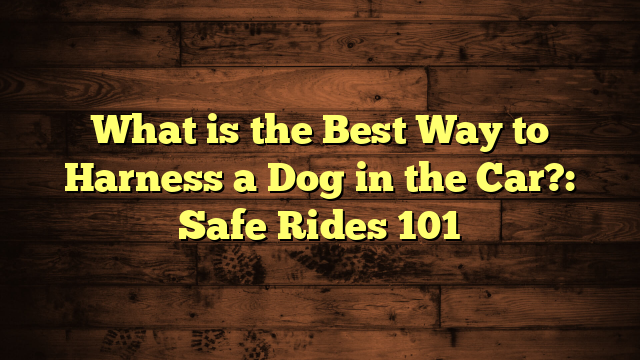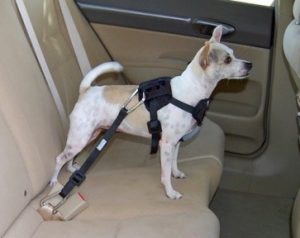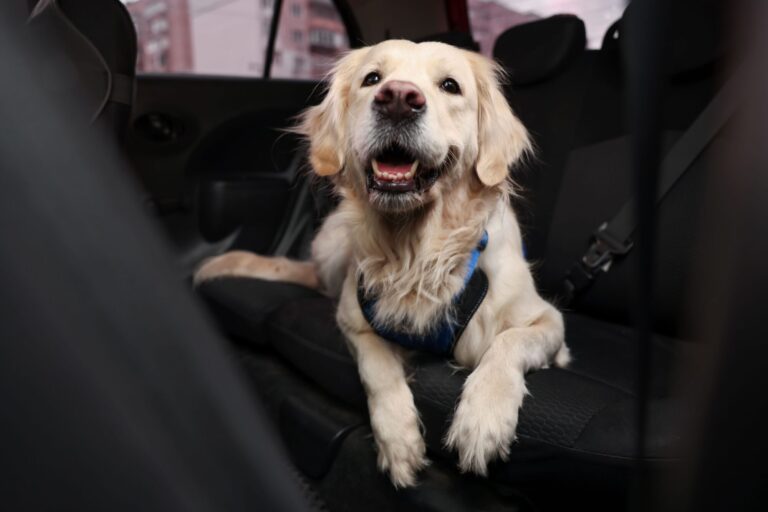Can I Use My Dog’s Harness With a Seatbelt? Safety First!
Yes, you can use your dog’s harness with a seatbelt. Ensure the harness is designed for car travel for safety.
Using a dog harness with a seatbelt is a great way to keep your pet secure during car rides. It prevents your dog from moving around too much, minimizing distractions while driving. This setup also protects your dog in case of sudden stops or accidents.
Make sure to choose a harness specifically designed for car use, as regular walking harnesses may not provide adequate protection. Look for features like padded straps and sturdy buckles. Properly securing your dog not only enhances their safety but also contributes to a more relaxed and enjoyable journey for both you and your pet.

Credit: www.motor1.com
Introduction To Canine Car Safety
Traveling with your furry friend can be a joy. Yet, it’s crucial to ensure your dog’s safety in the car. Just like humans, dogs need protection during travel. Using a harness with a seatbelt can be a practical solution.
Importance Of Restraining Pets
Restraining pets in the car is vital. Unrestrained pets can distract the driver. This increases the risk of an accident. A restrained pet is safer and less likely to be injured.
There are different ways to restrain pets. One common method is using a harness with a seatbelt. This setup helps to keep the pet secure and comfortable. It also ensures the driver can focus on the road.
Here are a few key points about restraining pets:
- Prevents distraction
- Reduces injury risk
- Keeps pets comfortable
Risks Of Unrestrained Dogs During Travel
Traveling with an unrestrained dog poses several risks. An unrestrained dog can become a projectile in an accident. This can cause severe injury to the dog and passengers.
Dogs can also become anxious and restless. This can lead to further distractions for the driver. An unrestrained dog can interfere with driving controls. This can lead to dangerous situations on the road.
Here are some risks associated with unrestrained dogs:
- Increased accident risk
- Potential for severe injuries
- Driver distraction
Using a harness with a seatbelt can help mitigate these risks. It ensures your dog remains safe and secure during travel.
Different Types Of Dog Restraints For Cars
Keeping your dog safe in the car is essential. There are various restraints you can use to secure your dog. Let’s explore the different types of dog restraints for cars.
Harnesses Vs. Crates
Harnesses are popular for securing dogs in cars. They attach to the seatbelt, keeping your dog in place. Crates provide a secure enclosure, preventing movement during travel.
Harnesses are easy to use and comfortable for dogs. They allow some freedom of movement while keeping your dog safe. Crates are more restrictive but offer better protection in case of an accident.
| Feature | Harness | Crate |
|---|---|---|
| Ease of Use | Easy | Moderate |
| Comfort | High | Moderate |
| Protection | Moderate | High |
Seat Belts For Dogs
Seat belts for dogs are another great option. They work similarly to harnesses but are more straightforward. You can clip the seat belt to your dog’s harness, ensuring they stay put.
- Seat belts are easy to use and adjust.
- They are often more affordable than crates.
- Seat belts offer moderate protection during sudden stops.
Choosing the right restraint depends on your dog’s size and behavior. Ensure your dog is comfortable and secure. This way, you can enjoy a safe and stress-free journey.
Compatibility Of Dog Harnesses With Seatbelts
Ensuring your dog’s safety during car rides is crucial. One way to do this is by using a harness that works with your car’s seatbelt system. But not all harnesses are created equal. Let’s explore the compatibility of dog harnesses with seatbelts.
Features Of Car-compatible Harnesses
Car-compatible harnesses have certain features that make them safe and effective for use with seatbelts.
- Sturdy Construction: These harnesses are made from durable materials that can withstand the force of a sudden stop.
- Attachment Points: They have specific attachment points for seatbelt straps, ensuring a secure fit.
- Padding: Extra padding provides comfort and reduces the risk of injury.
- Adjustability: Adjustable straps allow for a snug and custom fit for your dog.
Adapting Regular Harnesses
If you already have a harness for your dog, you might wonder if you can adapt it for car use. While it’s possible, there are important steps to take.
- Check for Strength: Ensure the harness is strong enough to handle sudden stops.
- Use Seatbelt Adapters: These can connect your dog’s harness to the car’s seatbelt system.
- Test the Fit: Make sure the harness fits well and does not allow too much movement.
- Consult the Manufacturer: Some harnesses are not designed for car use, so check with the manufacturer.
By understanding these features and steps, you can ensure your dog’s safety during car rides.

Credit: zugopet.com
Benefits Of Using A Harness With A Seatbelt
Using a harness with a seatbelt offers many benefits for both dogs and their owners. It ensures safety and comfort during car rides. Let’s delve into these benefits.
Improved Safety For Pets And Passengers
Safety is a primary concern for dog owners. A harness with a seatbelt keeps your dog secure. It prevents them from moving around and causing distractions.
In case of sudden stops or accidents, a harness reduces the risk of injury. It keeps your dog in place and prevents them from hitting the dashboard or windows.
Using a harness also ensures passenger safety. A secure dog won’t jump onto laps or interfere with the driver. This makes for a safer journey for everyone in the car.
Stress Reduction For Traveling Dogs
Traveling can be stressful for dogs. A harness with a seatbelt provides a sense of security. It mimics the feeling of being held, which can be comforting.
Dogs are less likely to experience travel anxiety. The harness keeps them stable and reduces motion sickness. This makes the trip more enjoyable for your furry friend.
Calm dogs make for a peaceful journey. They are less likely to bark or become agitated. This leads to a quieter and more pleasant trip for everyone.
Installation Guide For Harness And Seatbelt Systems
Securing your dog in the car is crucial for their safety. Using a harness with a seatbelt ensures that your pet stays safe during drives. Follow this guide to install the system correctly.
Step-by-step Setup
- Choose the right harness. Ensure it fits snugly but not too tight.
- Attach the harness to your dog. Make sure it is comfortable and secure.
- Locate the seatbelt clip in your car. It is usually near the seat.
- Connect the seatbelt to the harness. Ensure it clicks and locks properly.
- Adjust the seatbelt length. Your dog should have some movement but not too much.
Common Mistakes To Avoid
- Not checking the harness fit. A loose harness can be dangerous. </li
- Using the wrong seatbelt clip. Ensure compatibility with your car.
- Ignoring seatbelt adjustments. Always adjust to the right length.
- Skipping regular checks. Check the harness and seatbelt before each trip.
| Step | Action |
|---|---|
| 1 | Choose the right harness |
| 2 | Attach the harness to your dog |
| 3 | Locate the seatbelt clip |
| 4 | Connect the seatbelt to the harness |
| 5 | Adjust the seatbelt length |
Safety Certifications And Standards
Ensuring your dog’s harness is safe for use with a seatbelt is crucial. Safety certifications and standards play a key role in determining the reliability of these products. Knowing which certifications to look for can help keep your pet secure during car rides.
Certification Bodies For Pet Safety Products
Several organizations certify pet safety products. These bodies establish guidelines to ensure pet products meet safety requirements. Here are some of the key certification bodies:
- Center for Pet Safety (CPS): This non-profit organization conducts rigorous crash tests on pet harnesses.
- American Society for Testing and Materials (ASTM): They set standards for many consumer products, including pet safety gear.
- International Organization for Standardization (ISO): ISO provides international standards, including some related to pet safety.
What To Look For In Safety Certifications
When selecting a harness, look for specific safety certifications. These certifications ensure the product has passed various tests. Here are some features to check:
| Feature | Description |
|---|---|
| Crash Test Approval | Verify the harness has been crash-tested by reputable bodies like CPS. |
| Material Quality | Check for durable materials that can withstand impact. |
| Size and Fit | Ensure the harness fits your dog properly to avoid injuries. |
Make sure to verify the harness meets the latest safety standards. Reading reviews and consulting with your vet can also provide additional insights.
By paying attention to these details, you can make an informed choice. Your pet’s safety should always be the top priority.
Product Reviews: Top Harness And Seatbelt Combos
Many dog owners ask, “Can I use my dog’s harness with a seatbelt?” The answer is yes! Using a harness with a seatbelt is a great way to keep your dog safe in the car. In this section, we will review some of the best harness and seatbelt combos available. We will also explain the criteria for evaluation and recommend top products.
Criteria For Evaluation
To find the best harness and seatbelt combos, we looked at several factors:
- Safety: The harness must keep your dog secure.
- Comfort: The harness should be comfortable for your dog to wear.
- Durability: The harness and seatbelt should last a long time.
- Ease of Use: The harness and seatbelt should be easy to put on and take off.
- Price: The product should offer good value for money.
Recommended Products
| Product | Safety | Comfort | Durability | Ease of Use | Price |
|---|---|---|---|---|---|
| Kurgo Tru-Fit Smart Harness | ⭐⭐⭐⭐⭐ | ⭐⭐⭐⭐ | ⭐⭐⭐⭐⭐ | ⭐⭐⭐⭐ | $$$ |
| Sleepypod Clickit Sport | ⭐⭐⭐⭐⭐ | ⭐⭐⭐⭐⭐ | ⭐⭐⭐⭐⭐ | ⭐⭐⭐⭐⭐ | $$$$ |
| Vastar Adjustable Dog Car Seatbelt | ⭐⭐⭐⭐ | ⭐⭐⭐⭐ | ⭐⭐⭐⭐ | ⭐⭐⭐⭐⭐ | $ |
Kurgo Tru-Fit Smart Harness is a popular choice. It is known for its safety and durability. The harness is crash-tested and has steel buckles. It also has a padded chest plate for extra comfort. The price is reasonable, making it a great value.
Sleepypod Clickit Sport offers top-notch safety and comfort. It is crash-tested and meets the highest safety standards. The harness is easy to use and very durable. The price is higher, but the quality is worth it.
Vastar Adjustable Dog Car Seatbelt is the best budget option. It is adjustable and fits most harnesses. The seatbelt is easy to use and very affordable. It may not offer the same level of safety as the more expensive options, but it is still a good choice.
Diy Solutions For Securing Your Dog In The Car
Keeping your furry friend safe during car rides is essential. While there are many commercial products available, you can create your own solutions at home. Let’s explore some DIY methods to secure your dog using a harness and a seatbelt.
Homemade Harness Adaptations
You can adapt your dog’s existing harness to work with your car’s seatbelt. This approach is both cost-effective and simple.
- Using a carabiner: Attach a strong carabiner to the harness. Clip it onto the seatbelt for quick and secure fastening.
- Adding a seatbelt loop: Sew a loop of sturdy fabric onto the back of the harness. Thread the seatbelt through the loop to keep your dog in place.
- Double D-rings: Attach two D-rings to the harness. Use these rings to connect the seatbelt using a short strap.
Tips For A Diy Approach
Creating your own dog car harness setup requires some planning and care. Follow these tips for a safe and effective solution.
- Choose durable materials: Use strong, high-quality fabric and metal components to ensure safety.
- Test the setup: Try the harness and seatbelt combination in a parked car before hitting the road.
- Check for comfort: Make sure the harness fits snugly but comfortably on your dog.
- Regularly inspect: Check the harness and seatbelt connections for wear and tear. Replace any damaged parts immediately.
- Adjust as needed: Make necessary adjustments to the harness to accommodate your dog’s growth or changes in weight.
By following these tips, you can ensure your dog’s safety and comfort during car rides.
Traveling Tips For Dog Owners
Traveling with your dog can be a fun and enjoyable experience. Your dog’s safety and comfort are the top priorities. Here are some tips to help you and your dog have a smooth car ride.
Preparing Your Dog For Car Rides
- Start with short trips: Gradually increase the length of car rides.
- Use positive reinforcement: Give treats and praise to make the car a happy place.
- Secure your dog: Use a harness that connects to the seatbelt.
- Bring familiar items: Toys or blankets can help your dog feel at home.
Dealing With Anxiety And Motion Sickness
Some dogs may experience anxiety or motion sickness during car rides. Here are ways to help them:
- Keep the car cool: A comfortable temperature can reduce stress.
- Limit food before travel: Avoid feeding your dog a heavy meal before the trip.
- Frequent breaks: Stop often to let your dog stretch and relieve themselves.
- Consult your vet: For severe cases, your vet may recommend medication.
Legal Considerations And Responsibilities
Using a dog harness with a seatbelt is a smart choice. But, you must also understand the legal aspects. Different states have different rules. Knowing these rules helps you avoid fines and keep your pet safe.
State Laws On Pet Restraints
Each state has its own laws about pet restraints in vehicles. Some states require pets to be secured. Others recommend it but do not have strict laws. Check your state’s specific rules to stay compliant.
| State | Requirement |
|---|---|
| California | Pets must be restrained or in a crate |
| New Jersey | Fines for unrestrained pets |
| Texas | Recommends but does not require |
Liability In Case Of Accidents
If your pet is not restrained, you could be liable in an accident. Unrestrained pets can cause distractions. This increases the risk of accidents. In some states, you might face fines or even be at fault for the accident.
- Legal fines: Some states impose fines for unrestrained pets.
- Increased fault: You may be considered at fault if your pet causes an accident.
- Insurance issues: Unrestrained pets can lead to complications with insurance claims.
Conclusion: Prioritizing Canine Car Safety
Ensuring your dog’s safety during car rides is crucial. Using a harness with a seatbelt can provide protection and peace of mind. This practice is not just about following rules; it’s about loving and safeguarding your furry friend.
Final Thoughts On Using Harnesses With Seatbelts
Harnesses with seatbelts can reduce the risk of injury. They keep your dog secure and prevent distractions while driving. Properly fitted harnesses distribute force during sudden stops, minimizing harm. Make sure the harness is compatible with your car’s seatbelt system.
Consult your veterinarian for the best harness options. Regularly check the harness for wear and tear. Replace it if you find any damage to ensure continuous safety. Training your dog to stay calm and enjoy the ride can also help.
Encouraging Responsible Pet Ownership
Responsible pet ownership involves more than feeding and walking your dog. It includes ensuring safety in every situation. Using a harness with a seatbelt shows your commitment to your pet’s well-being.
Consider the following tips for responsible pet ownership:
- Invest in a high-quality harness designed for car travel.
- Regularly inspect and maintain the harness.
- Train your dog to sit calmly during rides.
- Avoid letting your dog roam freely in the car.
- Never leave your dog alone in the car.
By following these tips, you can ensure a safe and enjoyable journey for you and your pet. Prioritizing your dog’s safety shows love and care, making every car ride a pleasant experience.

Credit: www.kurgo.com
Frequently Asked Questions
Are Dog Harness Seatbelts Safe?
Yes, dog harness seatbelts are safe. They help protect dogs during car rides and prevent distractions for drivers. Always choose a well-fitted, crash-tested harness for maximum safety.
Can You Use A Harness As A Seatbelt?
No, you cannot use a harness as a seatbelt. Seatbelts are specifically designed for vehicle safety and compliance.
Can I Put My Dog In A Seat Belt?
Yes, you can put your dog in a seat belt. Use a specially designed pet seat belt for safety. Ensure it fits your dog properly. This helps protect your pet during car rides and prevents distractions. Always prioritize your dog’s comfort and security.
Can You Use A Regular Dog Harness In The Car?
Using a regular dog harness in the car is not recommended. Car-specific harnesses provide better safety. Ensure your dog’s safety with a crash-tested harness.
Conclusion
Ensuring your dog’s safety during car rides is crucial. Using a harness with a seatbelt can provide added security. Always check for compatibility and comfort. Investing in a high-quality harness and seatbelt attachment can make journeys safer. Prioritize your pet’s well-being for a stress-free travel experience.
Your furry friend deserves the best.
- Can I Get in a Taxi Without a Car Seat? - January 26, 2025
- Can I Get Chlamydia From a Toilet Seat? - January 26, 2025
- Can I Get an Uber With a Car Seat? - January 26, 2025






